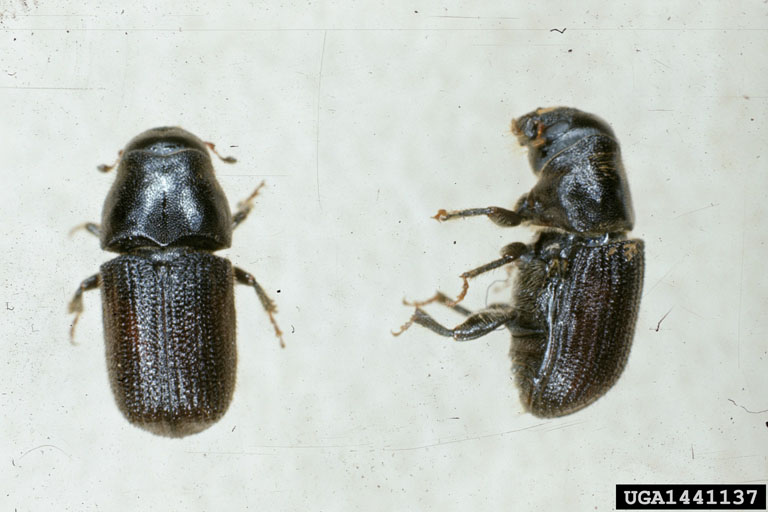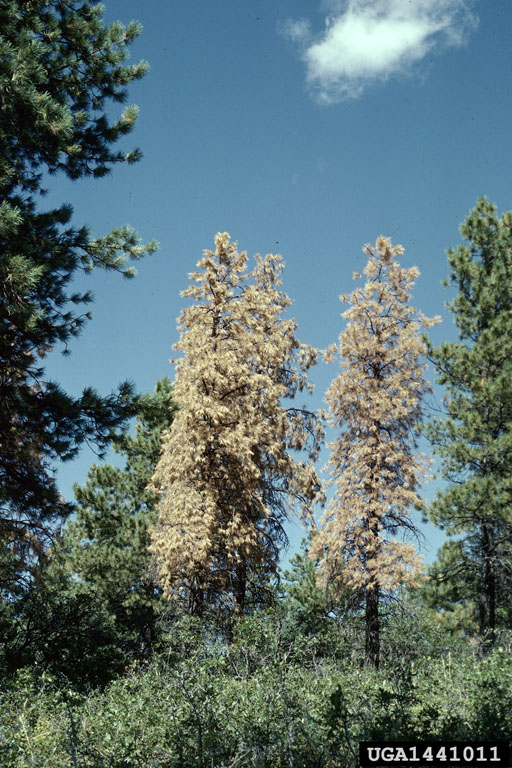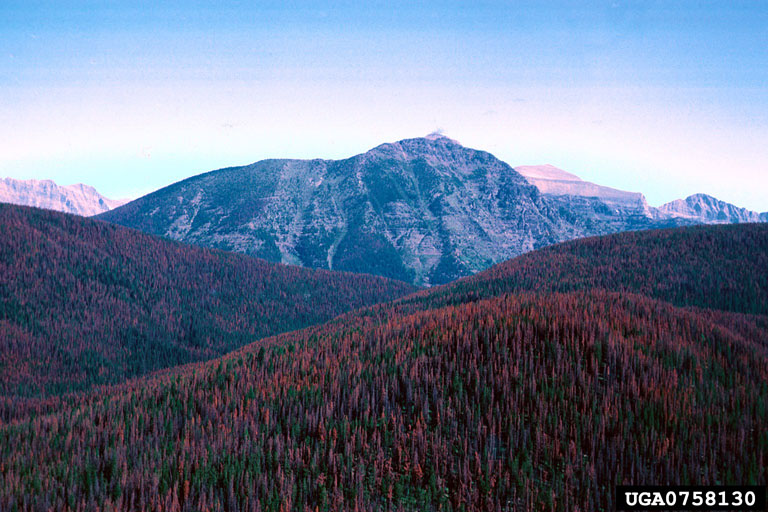Mountain pine beetle
Dendroctonus ponderosae
Key Wildlife Value:
The outbreak dynamics of mountain pine beetle differ depending on the pine host and stand type. In pure lodgepole pine stands, mountain pine beetle and stand-replacing fire are the key agents responsible for recycling older stands. Stand-replacing wildfires initiate even-aged stands. When an even-aged lodgepole stand reaches 80-100 years old, mountain pine beetles usually begin to attack the largest trees present, and within a 3-4 year period may kill nearly 80% of the trees in the stand. Advanced regeneration and smaller trees are all that remain after a severe mountain pine beetle outbreak in this host type. It is interesting to note that some very old and very large lodgepole pine trees appear inexplicably resistant to attack. In lodgepole stands that do not experience stand-replacing fire or a severe mountain pine beetle outbreak, multiple mountain pine beetle events of low to moderate severity serve to create or maintain a variable stand structure.
Distribution in Oregon and Washington:
Found throughout both states. (See also Important Habitats and Outbreak Dynamics).
Hosts:
All pines except Jeffrey pine are hosts.
Diagnosis:
The mountain pine beetle is one of several beetles attacking western pines that cause conspicuous masses of pitch, called pitch tubes, to form on the tree bole at points of entry.


Egg galleries are typically straight (2 and 3 needle pines) to broadly sinuous (five-needle pines), 76 cm (30 in) or longer, and run longitudinally up the tree bole.



Mountain pine beetle often kills trees in groups. Infested tree crowns usually fade within one year, changing from green to yellow-green to yellow or red-brown, depending on host species.

Life History:
The mountain pine beetle has a one-year life cycle. There are four life stages: egg, larva, pupa, and adult. During midsummer, unmated female beetles initiate attacks in standing trees at about eye level. After successfully boring through the bark, the pioneering females produce a pheromone that attracts males and other females. Once mating is completed, females deposit eggs along both sides of the egg gallery. Eggs hatch in 1 to 2 weeks, and the larvae tunnel away at right angles from the egg gallery. Mostly larvae but also some adults and pupae are present under the bark until the following spring. Pupation occurs during late spring in pupal cells constructed at the ends of the egg galleries, and the next generation of adults emerges in midsummer to colonize new trees.
Most trees are killed by beetles of a single generation. However, large sugar pines are first attacked in the crowns and two or more generations of beetles may attack successively lower portions before killing the trees. Adult beetles carry with them the spores of blue-staining fungi both on their bodies and in special structures on their heads called mycangia. The stain fungi are introduced into the sapwood as the beetles excavate egg galleries, where they aid the beetles in overcoming the tree by interrupting the flow of pitch and the flow of water to the crown. The mountain pine beetle is commonly associated with low-vigor trees weakened by injury, other disturbance agents, or overcrowding. During outbreaks, mountain pine beetle attacks apparently healthy trees and sometimes causes extensive mortality over large geographical areas.

Important Habitats and Outbreak Dynamics:
The mountain pine beetle is most active in locations east of the Cascades crest and in southwestern Oregon. Outbreaks are rare in other regions located west of the Cascades crest.
When population levels are low, mountain pine beetles breed in severely stressed trees such as those damaged by lightning, wind, fire, other insects, or disease. Mountain pine beetles normally do not reproduce in freshly cut trees, or in windthrown trees unless portions of their roots are still intact in the ground.
Susceptibility
Certain stand characteristics are particularly associated with mountain pine beetle activity in both pure pine stands and mixed conifer stands. The most important of these are tree diameter and spacing among trees. Stands having close spacing with trees of large diameter are more attractive to beetles than stands having wide spacing or stands having trees with small (averaging less than 15 cm) diameters. Dense stands containing large host trees provide visual cues and perhaps microclimates favored by mountain pine beetles for landing, and usually contain an abundance of trees that possess sufficient phloem thickness to support successful brood production yet offer little resistance to attack. Pure pine stands having these characteristics favor rapid increases in mountain pine beetle populations. Other stand characteristics correlated with mountain pine beetle outbreaks include older stand age, single-storied canopy structure, and high host abundance.
Significant mountain pine beetle activity in Oregon and Washington generally tends to occur under the following susceptible stand conditions:
- Pure, dense, even-aged lodgepole pine stands that are older than 90 years.
- Pure, dense, single-storied, second-growth ponderosa pine stands that are 50 to 100 years old.
- Dense mixed conifer stands containing scattered, medium-size to giant legacy pine trees that are sugar pines, western white pines, or ponderosa pines.
- High elevation stands of predominantly whitebark pine or western white pine with significant levels of white pine blister rust.
Table 1 displays “rules of thumb” threshold values for stand susceptibility to mountain pine beetle outbreaks in Oregon and Washington. Units are given in English units because of common use. Ponderosa pine basal area thresholds are known to vary with site quality, with poorer sites having lower thresholds and more productive sites having higher thresholds. The influence of site quality on the susceptibility of other pine species is not known, but is thought to be less important for lodgepole pine. Stands meeting or exceeding these thresholds have a high likelihood of experiencing significant structural changes during the next 10 years.
Table 1. Threshold values for mountain pine beetle risk in Oregon and Washington
| Host Susceptibility Class | Proportion of host1 (% tpa) | Average DBH of host (in) | Average Stand Basal Area1 (sq ft/acre) |
|---|---|---|---|
| Ponderosa pine | 75-100 | 8-12 1 | 150 (80-150)2 |
| Lodgepole pine | 75-100 | > 8 1 | 90 |
| Medium-size to giant legacy sugar pines | N/A | N/A | 180 |
| Medium-size to giant legacy ponderosa pines | N/A | N/A | 150 (80-150) 2 |
| Medium-size to giant legacy western white pines | N/A | > 14 3 | 140 |
| Whitebark pine | N/A | > 8 1 | Unknown |
1As computed for trees greater than or equal to 5 inches dbhAs computed for trees greater than or equal to 12.7 cm (5 in) dbh
2Varies with site quality. As a general rule, aim for a maximum of 80 sq ft/acre of basal area on dry sites, 100 to 120 sq ft/acre of basal area on moderate sites, and 150 sq ft/acre of basal area on wetter sites. Refer to Cochran (1992, 1994) for site-specific guidelines.
3Individual tree diameter
East of the Cascades crest, when mixed conifer stands contain ponderosa pine and mixtures of other pine species, such as lodgepole pine or western white pine, the other pine species present are often more susceptible to attack than ponderosa pine.
Mortality Patterns
Mortality typically occurs in discrete aggregations. During outbreaks group-kills often continue to expand outward until they coalesce. The larger-diameter host trees in a stand act as “focal points” for beetle attacks, and nearby small host trees are killed due to their proximity to the preferentially attacked large trees. Proportionally more large trees in a stand are killed than small trees.
Outbreak Dynamics
The outbreak dynamics of mountain pine beetle differ depending on the pine host and stand type. In pure lodgepole pine stands, the mountain pine beetle is the key agent responsible for recycling stands older than 90 years. When a lodgepole stand is about 100 years old, mountain pine beetles usually begin to attack the largest trees present, and within a 3-4 year period may kill nearly 80% of the trees in the stand. Advanced regeneration and smaller trees are all that remain after a typical mountain pine beetle event in this host type. Before the advent of fire suppression, wildfire usually followed the beetle outbreak, resulting in stand regeneration to lodgepole from seed. It is interesting to note that some very old and very large lodgepole pine trees appear inexplicably resistant to attack.
In second-growth ponderosa pine stands, the mountain pine beetle tends to act more as a thinning agent than a recycling agent. Outbreaks tend to develop slowly, beginning with scattered small groups of killed trees that become enlarged during successive years, sometimes reaching substantial sizes. Mortality during outbreaks, which is usually less dramatic than what is typically observed in lodgepole pine stands, tends to occur in patches with sizes ranging from individuals to large groups of trees. Intense mountain pine beetle activity in unthinned pole-size ponderosa pine stands retards the formation of large tree structure because the beetles preferentially attack the largest trees present. When low intensity beetle activity persists from year to year in a stand, it favors the development of increased structural and age diversity because the beetles preferentially attack a portion of the largest trees present each year, creating patches of mortality and associated new growth of various stages throughout the stand.
In mixed conifer stands, mountain pine beetle acts as a low level thinning agent, creating space for improved growth of residual trees, and accelerating the succession of mixed conifer stands to more shade tolerant species.
In high elevation systems, mountain pine beetle frequently colonizes individual mature, larger diameter whitebark pine or western white pine trees, especially those infected with white pine blister rust, a non-native introduced disease. Mountain pine beetle outbreaks in whitebark pine stands sometimes originate in lower elevation lodgepole pine stands, or, less commonly they may originate in whitebark pine stands themselves.
Opportunities for Manipulation to Increase Wildlife Habitat:
Densely stocked areas meeting risk criteria for mountain and western pine beetle could be selected for retention during selective cutting activities to provide attractive habitat for future pine beetle colonization. Although a more passive and less certain approach to snag creation than topping or girdling, such patches could provide attractive habitat for future bark beetle colonization, and also could be used in combination with active methods of snag creation.
It may be possible to create snags using mountain pine beetle attractant pheromones, but methodology has not been developed for this specific use. Attractant pheromones present some advantages over mechanical methods for creating snags, such as topping or girdling, in that they are less expensive, safer to administer, and mimic a natural process. Snags created using beetle attractant pheromones would provide good foraging habitat for woodpeckers due to the large numbers of beetle larvae that would occupy the snags during the year following initial colonization.
Potential Adverse Effects:
During severe outbreaks in second-growth ponderosa pine and lodgepole pine stands, the largest trees in the stand usually are killed first, delaying the development of large tree structure, and stocking levels may be reduced below desired levels. Abundant new snags and down wood are created in these areas, but the accompanying losses of existing cover and large stand structure also may degrade the quality of habitat available for some wildlife species, limit the quality and availability of future large dead wood structure, negatively affect high elevation water quality and quantity dynamics, impede movement through stands, increase ground fire severity, and degrade the aesthetic quality of forest landscapes.
In mixed conifer stands, structural and compositional diversity may be decreased when mountain pine beetle selectively removes legacy pines and other pine hosts from the stand, leaving stands of predominantly shade tolerant species. Legacy pines representing important and relatively rare structure that would take centuries to replace, may be removed from dense stands in a relatively short period by mountain pine beetle activity.
Five-needle pine species, such as sugar pine, western white pine, and whitebark pine, whose numbers are already dwindling from 1) infections of non-native white pine blister rust, 2) current management directions that favor denser stands with more shade tolerant species, and 3) the effects of fire suppression, may be unduly affected by mountain pine beetle activity.
Trees killed in campgrounds and other developed areas can pose hazards to public safety and structures, and may negatively affect screening, shading, and aesthetics.
How to Minimize the Risk of Adverse Effects:
Non-outbreak levels of mountain pine beetle populations are most effectively promoted by providing vigorous growing conditions for host stands, and by maintaining a diverse mosaic of age distributions and species compositions across the landscape.
The effects of mountain pine beetle can be minimized at the stand level by regulating stocking levels in accordance with site-specific stocking guidelines, such as those described by Cochran (1992) and Cochran et al (1994). Mixed conifer stands should be reduced to basal areas recommended for pure pine stands. Thinning can reduce tree mortality caused by mountain pine beetle even if conducted during an outbreak. When attacks do occur in thinned areas during outbreaks, their magnitude is significantly less than unthinned areas.
Thinning around individual legacy trees to promote tree vigor can minimize the risk of mountain pine beetle attack. These spot treatments typically involve removal of all shrubs and trees beneath the canopy of the tree to a prescribed distance (often 7.6 m) beyond the dripline. This strategy is most suitable for sugar pine, ponderosa pine, and western white pine.
The semiochemical verbenone may be used for short-term protection of individual ponderosa, lodgepole, and whitebark pine trees from mountain pine beetle. Although it does not offer 100 percent protection and must be reapplied annually until beetle pressure subsides, it can be a useful tool for reducing beetle-caused mortality. The efficacy of verbenone is unknown for individual tree protection of sugar pine and western white pine, but likely is similar to that of the previously mentioned pines. For area protection, verbenone-only formulations have provided inconsistent and unreliable protection from mountain pine beetle.
In certain circumstances it may be desirable to protect high-value trees and areas, such as campgrounds, using chemical control methods. Several commercially available formulations of insecticides, both bole-applied and injectable, are effective in preventing mountain pine beetle attack. Proper timing of injectable insecticide application, to allow adequate distribution of the material in the tree before beetle flight occurs, is critical to success.
References
Amman, G.D., M.D. McGregor, R.F. Schmitz, and R.D. Oakes. 1988. Susceptibility of lodgepole pine infestation by mountain pine beetles following partial cutting of stands. Can. J. For. Res. 18:688-695.
Anhold, J.A. and J.N Long. 1996. Management of lodgepole pine stand density to reduce susceptibility to mountain pine beetle attack. West. J. Appl. For. 11(2):50-53.
Cochran, P.H. 1992. Stocking levels and underlying assumptions for uneven-aged ponderosa pine stands. USDA Forest Service, Pacific Northwest Research Station, Portland, OR. Research Note PNW-RN-509. 10 pp.
Cochran, P.H., J.M. Geist, D.L. Clemens, R.R. Clusnitzer, and D.C. Powell. 1994. Suggested stocking levels for forest stands in northeastern Oregon and Washington. USDA Forest Service, Pacific Northwest Research Station, Portland, OR. Research Note PNW-RN-513. 21 pp.
Gibson, K., S. Kegley, and B. Bentz. 2009. Mountain pine beetle. Forest Insect & Disease Leaflet 2 (revised). USDA Forest Service, Portland, OR. FS-R6-RO-FIDL#2/002-2009. 12 p.
Goheen, D.J., E.M. Goheen, and K. Marshall. 1998. Wolfpine Thinning Evaluation Establishment Report. USDA Forest Service, Pacific Northwest Region, Southwest Oregon Forest Insects and Diseases Technical Center, Medford, OR. SWOFIDTC 98-1. 9 pp.
L.M. Ganio and R.A. Progar. 2017. Mortality predictions of fire-injured large Douglas-fir and ponderosa pine in Oregon and Washington, USA. Forest Ecology and Management 390:47-67.
Goheen, E.M., D.J. Goheen, K. Marshall, R.S. Danchok, J.A. Petrick, and E.E. White. 2002. The status of whitebark pine along the Pacific Crest National Scenic Trail on the Umpqua National Forest. 2002. USDA Forest Service, Pacific Northwest Research Station, Portland, OR. Gen. Tech. Rep. PNW-GTR-530. 25 pp. http://www.fs.fed.us/pnw/pubs/gtr530.pdf
Goheen, E.M. and E.A. Willhite. 2006. Field guide to common diseases and insect pests of Oregon and Washington conifers. USDA Forest Service, Pacific Northwest Region, Portland, OR. R6-NR-FID-PR-01-06. 335 pp. http://www.biodiversitylibrary.org/bibliography/80321#/summary
McGregor, M.D., and D.M. Cole. 1985. Integrating management strategies for the mountain pine beetle with multiple-resource management of lodgepole pine forests. USDA Forest Service Intermountain Forest and Range Exper. Sta., Ogden, UT. Gen. Tech. Report INT-174. 68 p.
Mitchell, R.G., and H.K. Preisler. 1991. Analysis of spatial patterns of lodgepole pine attacked by outbreak populations of the mountain pine beetle. Forest Science 37(5):1390-1408.
Mitchell, R.G., R.H. Waring, and G.B. Pitman, 1983. Thinning lodgepole pine increases tree vigor and resistance to mountain pine beetle. Forest Science 29(1):204-211.
Preisler, H.K. and R.G. Mitchell. 1993. Colonization patterns of the mountain pine beetle in thinned and unthinned lodgepole pine stands. Forest Science 89(3):528-545.
Sartwell, C. and R.E. Dolph, Jr. 1976. Silvicultural and direct control of mountain pine beetle in second-growth ponderosa pine. USDA Forest Service, Pacific Northwest Forest and Range Exper. Sta., Portland, OR. Research Note PNW-268. 8 pp.
Sartwell, C., and R.E. Stevens. 1975. Mountain pine beetle in ponderosa pine--prospects for silvicultural control in second-growth stands. J. For. 73:136-140.